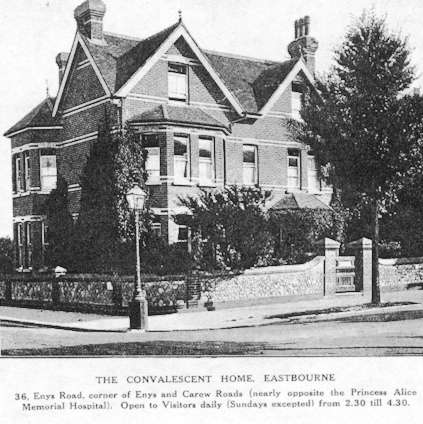The Homeopathic Convalescent Home Eastbourne
June 25, 2010
**  The
Homeopathic Convalescent Home in
Eastbourne**
(*photo used courtesy of Homéopathe
International by Sylvain
Cazalet at PHOTOTHÈQUE
HOMÉOPATHIQUE) 36, Enys Road,
corner of Enys and Carew Roads (nearly opposite the Princess Alice
Memorial Hospital), opened in 1888 under the
management (Anon, The
Hahnemannian Monthly, Volume
53,
(LaBarre Printing Company, 1918). Page 318) of the London Homeopathic
Hospital,
The
Homeopathic Convalescent Home in
Eastbourne**
(*photo used courtesy of Homéopathe
International by Sylvain
Cazalet at PHOTOTHÈQUE
HOMÉOPATHIQUE) 36, Enys Road,
corner of Enys and Carew Roads (nearly opposite the Princess Alice
Memorial Hospital), opened in 1888 under the
management (Anon, The
Hahnemannian Monthly, Volume
53,
(LaBarre Printing Company, 1918). Page 318) of the London Homeopathic
Hospital,
Sponsors: William Debenham,
Physicians: Alex Henry Croucher, W Roche, Knox Shaw,
Matron: Ms. Batty,
Secretary Superintendent: G A Cross,
?1875 - Alex Henry Croucher founds the Eastbourne Homeopathic Dispensary,
1889 - the Home had 18 beds,
1891 - the Home contains 21 beds and admits 18 patients,
1895 - 1200 patients seen since the opening of the Home,
1900 - a subscribers letter is required for admittance to the Home, and a small weekly fee is paid,
1934 - Ms. L Potter, a midwife and nurse trained at the London Homeopathic Hospital, became Sister in Charge of the Home (she was previously a Staff Nurse at the Royal Free Hospital and Surgical Ward Sister at the General Hospital Walsall),
See also http://www.homeoint.org/morrell/londonhh/eastbour.htm The History of the Convalescent Home at Eastbourne by Peter Morrell and Sylvain Cazalet. A Convalescent Home more than any other requires a woman’s help and guidance, and the Hospital was particularly fortunate in securing the active efforts and munificence of Mrs. Clifton Brown, who, together with William Vaughan Morgan, founded the Homeopathic Convalescent Home at Eastbourne.
The Home was opened on Saturday, August 25, 1888. To the indefatigable efforts of the chairman, William Vaughan Morgan, in the foundation and organisation of the institution, and to his indomitable energy and influence with other kind friends, the existence of the Home is due, and in the establishment of this new institution a fresh debt was added to those which the cause and friends of homeopathy already owed to him.
It is interesting at the present day to recall the names of some of the generous donors who assisted in making the Home possible, many of whom have unfortunately now passed away: Hugh Cameron, who assisted at the foundation of the London Homeopathic Hospital itself and rallied his friends to help in the establishment of the Home by donations amounting to over £ 1,100; Mrs. Clifton Brown, whose munificent gift of £ 1,000 at once made the establishment of the Home possible; Mrs. William Vaughan Morgan, Miss J. Durning Smith, Miss Barton, Miss Isabella Barton, Mr. and Mrs Frank Smart, James Spicer, the Earl of Dysart, Henry Tate, Miss Houldsworth, William Debenham, Maurice Powell, Miss C. A. Stilwell and Mrs. Whateley Willis, were among a large number of liberal donors to the Foundation Fund.
The total amount received in donations, including the proceeds of a concert at Hugh Lupus Grosvenor 1st Duke of Westminster’s London residence, was £ 3,251. This amount enabled the Board to purchase the lease of the house and furnish it, and also meet the unavoidable expenses of its organisation and establishment, without drawing on the subscription list.
The first legacy received for the Home was bequeathed to it while yet the scheme was in an undeveloped stage. Major General Sir James Edward Alexander for many years a firm homeopathist and member of the Board of Management of the London Homeopathic Hospital, bequeathed in 1887 the sum of £500 to form the first investment for its maintenance. This good example has been emulated by many friends since.
It is to be regretted that in one important particular the original scheme has not yet been carried into effect. The Home was primarily designed for men, women and children, as well as for the nurses of the Hospital. Unfortunately, in a house of its size, the reception of men patients is impossible, and so perforce the patients have up to the present been limited to nurses, women and children.
It must be remembered that male patients are, of all others, those for whom the benefits of a convalescent home are most urgently needed. It is on their health that the maintenance of their families depends. Experience at the Hospital has proved that male patients, forced to resume their daily work too soon after serious illness, are liable to return to the Hospital wards after a brief absence, whereas two or three weeks at the seaside, passed in freedom from cares and under favourable conditions, would have given them a long lease of health and strength.
For the moment the male patients of the Hospital are being sent to a convalescent home at Bexhill-on-Sea, by arrangement with that institution.
It is intended to provide a home for the reception of male patients so soon as arrangements can be made. The sum o £ 3,184 has already been contributed for the purpose. The Home has bestowed its benefits during the 25 years of its existence of 5,000 persons, its admissions numbering 200 annually.
It is maintained by annual subscriptions and is preserved from debt by the income from a legacy left to it by William Vaughan Morgan.